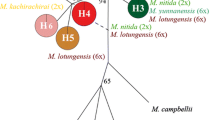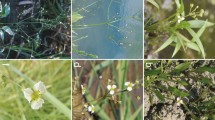Abstract
Comparative analyses were made of agamospermous populations of Eupatorium sessilifolium, which have previously been documented to be polyploid, to determine whether they are alloploid or autoploid in origin and to assess the possibility that they have arisen more than once. There was no variability in ITS sequences among seven agamospermous and eight sexual diploid populations of E. sessilifolium, which is consistent with morphological observations in suggesting that the agamospermous populations were autoploids. The ITS sequence characteristic of E. sessilifolium differs from all other North American species by a minimum of 15 changes, and heterogeneity or polymorphism would be expected if the agamospermous populations were alloploids. Analysis of the chloroplast-based trnC-psbM spacer region showed variability among both sexual diploid and agamospermous populations of E. sessilifolium, which suggested that the agamospermous populations stem from multiple origins. Analysis of ISSR data revealed considerable intraspecific variability within E. sessilifolium, and the distribution of variability, with agamospermous populations showing variability from one another, added further evidence for multiple origins of agamospermous populations. The results in conjunction with distributional evidence that the sexual diploid populations of E. sessilifolium are geographically restricted and uncommon suggest that monitoring of populations might be warranted to evaluate whether measures are needed to enhance their continued survival.




Similar content being viewed by others
References
Doyle JJ, Doyle JL (1987) A rapid DNA isolation procedure for small quantities of fresh leaf tissue. Phytochem Bull 19:11–15
Felsenstein J (1985) Confidence limits on phylogenies: an approach using the bootstrap. Evolution 39:783–791
Flagel LE, Rapp RE, Grover CE, Widrlechner MP, Hawkins J, Grafenberg JL, Álvarez I, Chung GY, Wendel JF (2008) Phylogenetic, morphological, and chemotaxonomic incongruence in the North American endemic genus Echinacea. Amer J Bot 95:756–765
Grant WF (1953) A cytotaxonomic study in the genus Eupatorium. Amer J Bot 40:729–742
Grant V (1981) Plant speciation, 2nd edn. Columbia University Press, New York
Hollingsworth ML, Bailey JP (2000) Evidence for massive clonal growth in the invasive weed Fallopia japonica (Japanese knotweed). Bot J Linn Soc 133:463–472
Montgomery JD, Fairbrothers DE (1970) A biosystematic study of the Eupatorium rotundifolium complex (Compositae). Brittonia 22:134–150
Nei M, Li WH (1979) Mathematical model for studying genetic variation in terms of restriction endonucleases. Proc Natl Acad Sci USA 76:5269–5273
Poulin J, Weller SG, Sakai AK (2005) Genetic diversity does not affect the invasiveness of fountain grass (Pennisetum setaceum) in Arizona, California and Hawaii. Divers Distrib 11:241–247
Reddy MP, Sarla N, Siddiq EA (2002) Inter simple sequence repeat (ISSR) polymorphism and its application in plant breeding. Euphytica 128:9–17
Schilling EE, LeBlond RJ, Sorrie BA, Weakley AS (2007) The relationships of the New England Boneset, Eupatorium novae-angliae (Asteraceae). Rhodora 109:145–160
Schmidt GJ, Schilling EE (2000) Phylogeny and biogeography of Eupatorium (Asteraceae: Eupatorieae) based on nuclear ITS sequence data. Amer J Bot 87:716–726
Shaw J, Lickey EB, Beck JT, Farmer SB, Liu W, Miller J, Siripun KC, Winder CT, Schilling EE, Small RL (2005) The tortoise and the hare II: relative utility of 21 noncoding chloroplast DNA sequences for phylogenetic analysis. Amer J Bot 92:142–166
Siripun KC, Schilling EE (2006a) Molecular confirmation of the hybrid origin of Eupatorium godfreyanum (Asteraceae). Amer J Bot 93:319–325
Siripun KC, Schilling EE (2006b) Eupatorium, in Flora North America, Vol. 21: pp 462–474
Soltis DE, Soltis PS, Tate JA (2003) Advances in the study of polyploidy since Plant speciation. New Phytol 161:173–191
Soltis DE, Morris AB, McLachlan JS, Manos PS, Soltis PS (2006) Comparative phylogeography of unglaciated eastern North America. Molec Ecol 15:4261–4293
Soltis DE, Soltis PS, Schemske DW, Hancock JF, Thompson JN, Husband BC, Judd WS (2007) Autopolyploidy in angiosperms: have we grossly underestimated the number of species? Taxon 56:13–30
Sullivan VI (1972) Investigation of the breeding systems, formation of auto- and alloploids and the reticulate pattern of hybridization in North American Eupatorium (Compositae). PhD dissertation, Florida State University, Tallahassee/University Microfilms, Ann Arbor
Sullivan VI (1976) Diploidy, polyploidy, and agamospermy among species of Eupatorium (Compositae). Canad J Bot 54:2907–2917
Sullivan VI, Neigel J, Miao B (1991) Bias in inheritance of chloroplast DNA and mechanisms of hybridization between wind-pollinated and insect-pollinated Eupatorium (Asteraceae). Amer J Bot 78:695–705
Swofford DL (2003) PAUP*. Phylogenetic analysis using parsimony (* and other methods). Version 4. Sinauer Associates, Sunderland
van Dijk PJ, Vijverberg K (2005) The significance of apomixis in the evolution of the angiosperms: a reappraisal. In: Bakker FT, Charton LW, Gravendeel B, Pelser PB (eds) Plant species-level systematics: new perspectives on pattern & process. Koeltz Scientific Books, Koenigstein, pp 101–116
White TJ, Bruns T, Lee S, Taylor J (1990) Amplification and direct sequencing of fungal ribosomal RNA genes for phylogenetics. In: Innis MA, Gelfand DH, Sninsky JJ, White TJ (eds) PCR protocols: a guide to methods and applications. Academic Press, San Diego, pp 315–322
Wolfe AD (2005) ISSR techniques for evolutionary biology. Meth Enzymol 395:134–144
Wolfe AD, Liston A (1998) Contributions of PCR-based methods to plant systematics and evolution biology. In: Soltis DE, Soltis PS, Doyle JJ (eds) Molecular systematics of plants II. Kluwer, New York, pp 43–86
Xu C-Y, Zhang W-J, Fu C-Z, Lu B-R (2003) Genetic diversity of alligator weed in China by RAPD analysis. Biodivers Conserv 12:637–645
Yahara T, Sullivan VI (1986) Peroxidase phenotypes of Eupatorium mohrii and E. scabridum (Compositae), widespread all-agamospermous “species” in the southeastern United States. Pl Spec Biol 1:27–34
Yahara T, Ito M, Watanabe K, Crawford DJ (1991) Very low genetic heterozygosities in sexual and agamospermous populations of Eupatorium altissimum (Asteraceae). Amer J Bot 78:706–710
Acknowledgments
The authors are grateful to G. Beattie, S. Robertson, and D. E. Schilling for technical help. Financial support was provided by grants from the US National Science Foundation (DEB-0343684) and the Hesler Fund of the University of Tennessee.
Author information
Authors and Affiliations
Corresponding author
Rights and permissions
About this article
Cite this article
Grubbs, K.C., Small, R.L. & Schilling, E.E. Evidence for multiple, autoploid origins of agamospermous populations in Eupatorium sessilifolium (Asteraceae). Plant Syst Evol 279, 151–161 (2009). https://doi.org/10.1007/s00606-009-0155-y
Received:
Accepted:
Published:
Issue Date:
DOI: https://doi.org/10.1007/s00606-009-0155-y




